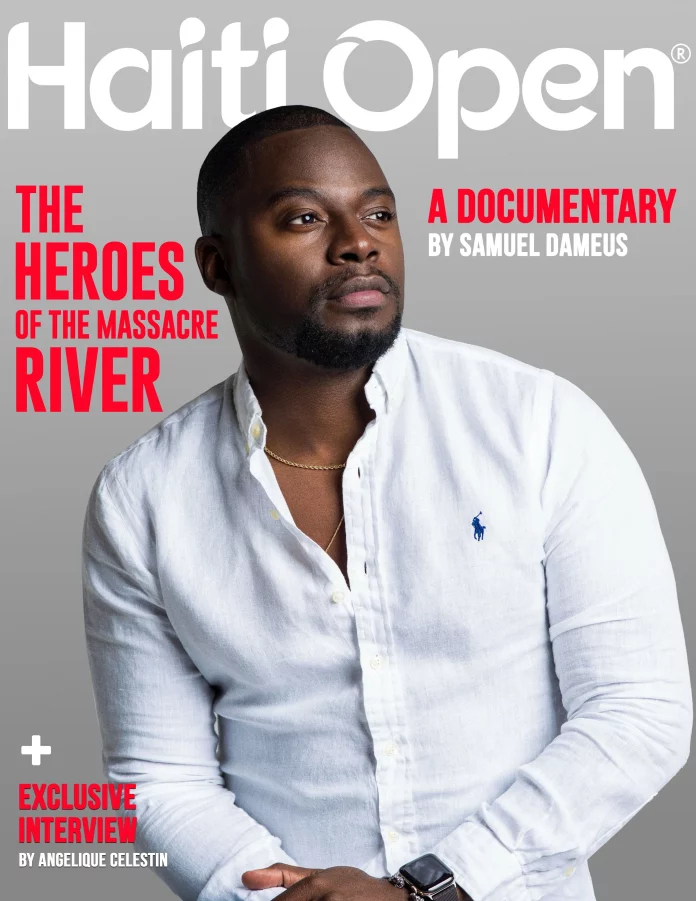The Heroes of the Massacre River Premieres May 30 at Little Haiti Cultural Center
A documentary by Samuel Dameus chronicles Haiti’s new legacy of unity, resilience, and revolutionary community action.
By Angelique Celestin
On Friday, May 30th, the Little Haiti Cultural Center in Miami will host the premiere of The Heroes of the Massacre River, a powerful and deeply emotional documentary that captures one of the most significant chapters in contemporary Haitian history, the construction of the Canal of Ouanaminthe.
Directed and produced by Haitian filmmaker and cultural visionary Samuel Dameus, the documentary tells the story of how a canal, dug by hand, with spirit and solidarity, became a symbol of national pride and cross-generational unity. It celebrates not only the physical labor behind the canal but also the spiritual and social momentum it inspired across the Haitian population and its vast diaspora.
“I think the Kanal experience needed to be documented,” says Dameus. “We don’t have many historical events that have been properly captured. In 1804, we didn’t have the means to document the revolution. But today, we do. This is for the generations that will follow, so they can understand their heritage and feel proud of it.“
A Story of Real Heroes
The documentary pays homage to both prominent figures and everyday citizens who stepped into leadership roles, not through appointment, but through action. Among the voices and faces featured in the film are Angie Clervil, Dr. Bertrhude Albert, Dr. Naismy-Mary Fleurant, Architect Wideline Pierre, Economist Etzer Emile, and canal workers Milourie Sylfrard, Theodore Johnson, and Joseph Pressoir, people who gave their time, talent, and sweat to a cause greater than themselves.
“These were not heroes chosen by any organization or government,” Dameus explains. “They were simply moved by the moment, compelled by a shared sense of duty. They became the heroes of this story by showing up when it mattered most.“
The canal itself runs deeper than irrigation or water flow, it’s a modern landmark of Haitian resistance and autonomy. Born from the desire to protect the livelihoods of farmers and communities along the Massacre River, its construction united the country in ways rarely seen in recent decades. Many people do not know the history of the river and where it got its name. The Dajabón River, as it was called before, forms the northernmost part of the international border between the Dominican Republic and Haiti. It was named by the Arawak-speaking indigenous inhabitants of the island, the Taínos, as “Dahabōn”, which derivates from dajaus, a freshwater fish that lives in the Caribbean region. Its name was changed as a reference to a massacre of French buccaneers by Spanish colonizers in the 17th century. The river also witnessed another, massacre of Haitians and Black Dominicans by the Dominican State in 1937, but today with the building of the canal, we have changed the trajectory of history from tragedy and conflict to conquest, reunification, but most of all independence.
Art in the Face of Adversity
The production of The Heroes of the Massacre River was, in itself, a triumph over adversity. With no formal pre-production phase, minimal staffing, and a severely limited budget, Dameus and his team managed to pull together the film in just one week.
“The country was going through so much. We didn’t have time, staff, or money,” recalls Dameus. “Normally a project like this would take over six figures to produce. We made it happen with barely $15,000. But it came from the heart. This was love for Haiti captured on camera.“
Behind the scenes, an all-star creative team brought the project to life: Joseph Conventong (Director of Photography), Ricardo Compere (Drone/Camera), Fanfan Casimir (Camera), Emmanuel “Manno Beats” Pierre (Score & Sound Arrangement), Vox Sambou (Music), ChartVisuals (VFX), Akomicsart (Art), and production coordination by Angie Bell and Atizan International. The film was produced by Facesofhaiti and realized by BOYOFilms, Dameus’ own media company known for its commitment to Haitian narratives and identity.
Beyond Borders: A Message of Reconciliation
Though the Massacre River has historically been a site of trauma and tension between Haiti and the Dominican Republic, this film strives to rewrite that legacy into one of shared humanity and mutual possibility.
“This was never a film to pit Haitians against Dominicans,” Dameus emphasizes. “Instead, it’s a look at what happens when people choose to work together. The Canal became a moment of unification, and I hope the film does the same, especially for young people and those in the diaspora.“
For Dameus, this project is also about reframing the Haitian diaspora’s role in rebuilding the nation, not simply as financial supporters, but as active architects of progress.
“This film shows the diaspora what’s possible when they get involved beyond remittances,” he says. “They helped make the Canal possible. And they can be part of the next major movement too. This is about awakening that responsibility and pride in all of us.“
The Premiere and Beyond
The premiere of The Heroes of the Massacre River on May 30th promises to be more than a film screening. It’s a cultural gathering, a reunion of purpose, and a call to action. Following the premiere, the documentary will be available for viewing online at www.boyofilms.com, ensuring that the message travels far beyond the theater’s walls.
In an age where Haiti is too often reduced to crisis headlines, The Heroes of the Massacre River offers a new image: one of community, dignity, and a shared future forged by its own people.
“We are documenting our own story now,” Dameus says. “And that changes everything.“
EVENT DETAILS
Date: Thursday, May 30, 2025
Time: 6:00 PM – 9:00 PM
Location: Little Haiti Cultural Center, Miami, FL
Tickets & Info: www.boyofilms.com

